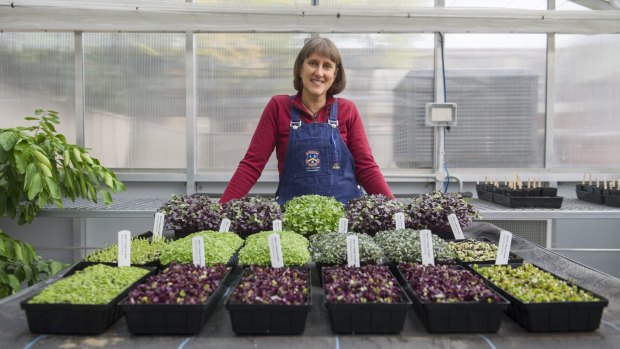This was published 8 years ago
Merici College grows microgreens for Canberra restaurants
By Clare Colley
Order a dish from any on-trend restaurant and the chances are it will come with a sprinkling of microherbs on top, but the microgreens at two Canberra restaurants come from an unlikely source – a school greenhouse.
Merici College opened its vegetable garden and chicken pen in a disused basketball court in 2011 to supply food for the college canteen under the care of sustainability teacher Fiona Buining.

Merici College sustainability teacher Fiona Buining with the microgreens she grows in the school's greenhouse.Credit: Jay Cronan
About two years ago Fiona started growing microgreens in the greenhouse for use in the canteen and the school's restaurant run by its hospitality students.
At the end of 2013 she started selling the "little carpets of seedlings" to chef Janet Jeffs from The Conservatory restaurant at the National Arboretum and now makes about $120 for the college each week since she began selling to A.Baker at the beginning of this year.
"It is integrated into the learning and teaching I do with students they learn you can grow things and sell them," she said.
"It's one thing to grow for yourself, it's another thing to grow it and sell it, there are things around quality control."
Unlike other sellers of hydroponic microgreens Fiona grows all her plants in reusable trays with soil to cut back on waste.
"There's really nothing to throw away, at the arboretum they put the soil out the back… and at A.Baker they've got a garden as well so the soil doesn't get wasted and I pick up the trays and wash them and reuse them," she said.
"It's also really low food miles; it's a 22-kilometre round trip to deliver to both places each week."
Fiona said microgreens were harvested when the plants were very young – around two weeks old – depending on the variety.
"They're different from sprouts because with a sprout you're eating the whole thing… with microgreen you're just eating the shoots," she said.
"There's a lot of research out about microgreens, they're very nutrient dense because you're eating very young plants… they're really good for you and they're a really fresh product."
Fiona said both chefs were supportive of the school's garden with similar philosophies about using locally grown produce.
Janet said her business advocated for a "good, clean and fair" food economy with the freshest seasonal ingredients produced sustainably and locally.
"We mainly use [the microgreens] to garnish our breakfast dishes on the weekends because Fiona delivers them on Friday afternoons and we use them all by Sunday," she said.
"[The plants] are fresh, small, unusual, colourful, nutritious and I get to chat to my mate Fiona when she delivers them."
The college's greenhouse is currently home to purple radish, daikon radish, red cabbage, mizuna, soy beans, chickpeas and perilla, but the microgreen varieties change throughout the year.
The microgreens can also be sampled at the school's restaurant The Bridge open to the public for lunch every second Wednesday.